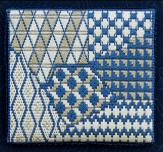
|
I currently offer several classes in the Rozashi technique. To see the details, click on the class title or picture for the class you'd like to see. (NOTE: With silk cost rising rapidly and the Dollar weak against the Yen, kit costs will continue to rise.) |

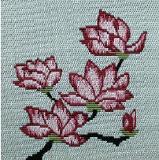
|
Magnolia kobus is the focal point in many Japanese gardens, as well as in art. Fumiko Ozaki has designed a branch of Japanese magnolia blossoms for our study. She honors us with this design. Finished piece measures approximately 5.5"x 5.5" (17.0 cm x 17.0 cm). |
|
Baby Iris is a beginning study in the Japanese needlework technique of Rozashi. The class will teach the very basic stitches and prepare the participants to pursue Rozashi. |
|
All kits include: · Frame · Mounted ro w/ drawing · All required threads · Rozashi needle Complete instructions |
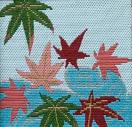
|
Autumn’s Pool is a study in traditional Rozashi stitches. The maple tree is revered in Japan. This piece teaches a wide variety of Rozashi stitches and produces a beautiful result. |
|
Tropical fish is worked in Rozashi. The fish is tropical shades with accents. The stitches are the irregular, ichi dan, Rozashi satin, and line stitch. All stitches are traditional to Rozashi. The fish is appliquéd onto a silk fabric and finished with a silver metallic Rozashi thread. |
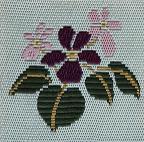
|
Sweet Violet is a small study in the basics of Rozashi. Rozashi is a Japanese needlepoint/counted technique that dates back to 700 A.D. The materials in this small study are traditional to Rozashi. A tightly twisted silk thread is the main silk used. It is like no other silk twist. |
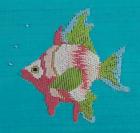
|
In Flower Cloud with Butterfly the mum is the most revered of flowers in Japan. The colorful butterfly is a rainbow of colors. The design is beautiful and traditional. |

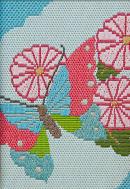
|
. |
|
From early times until today, artisans have used the motif on textiles, in embroidery, porcelains, paintings and lacquer ware. Join us in creating a magnificent camellia in Rozashi. The blossom and bud are worked in the red rose family. The leaves and stems are in greens, with the veins worked in gold metallic. |
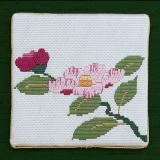
|
The Patterns in Blue and Green is a study in traditional Japanese Patterns. The sections are created to blend into each other without true definitions The colors are navy, dark green, light green and a pale green urushi thread. The finished piece is suitable for a small box top, an insert in a larger embroidery, or a small hanging. The threads are silk and urushi. |
